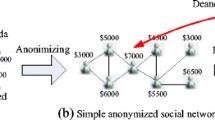Abstract
Privacy protection is one of the most challenging problems of social networks. Simple removal of the labels is unable to protect the privacy of social networks because the information of graph structures can be utilized to deanonymize target nodes. Previous related proposals mostly assume that attacker knows only the target’s neighborhood graph, but ignoring of signed edge attribute. The graph structure with signed edge attributes could cause serious privacy leakage of social networks. In this paper, we take the signed attribute of edges into account when achieving k-anonymity privacy protection for social networks. We propose a signed k-anonymity scheme to protect the privacy of key entities in social networks. With signed k-anonymity protection, these targets cannot be re-identified by attackers with confidence higher than 1 / k. The proposed scheme minimizes the modification, which preserves high utility of the original data. Extensive experiments on real data sets and synthetic graph illustrate the effectiveness of the proposed scheme.






Similar content being viewed by others
References
Scott, J.: Social Network Analysis. Sage Publication Ltd, London (2017)
Wu, T., Liu, S., Zhang, J., Xiang, Y.: Twitter spam detection based on deep learning. In: Proceedings of the Australasian Computer Science Week Multi conference, pp. 1–8 (2017)
Gao, J., Liu, P., Kang, X., Zhang, L., Wang, J.: PRS: parallel relaxation simulation for massive graphs. Comput. J. 59(6), 848–860 (2016)
Gao, J., Song, B., Ke, W., Hu, X.: BalanceAli: multiple PPI network alignment with balanced high coverage and consistency. IEEE Trans. NanoBiosci. 16(5), 333–340 (2017)
Yan, F., Gao, J.: Reliable NoC design with low latency and power consumption. Electron. Lett. 53(6), 382–383 (2017)
Shi, X., Liang, J., Di, S., He, B., Jin, H., Lu, L., Wang, Z., Luo, X., Zhong, J.: Optimization of asynchronous graph processing on GPU with hybrid coloring model. In: Proceedings of ACM SIGPLAN Symposium on Principles and Practice of Parallel Programming, pp. 271–272 (2015)
Liu, H., Huang, H.: Enterprise: breadth-first graph traversal on GPUs. In: Proceedings of IEEE/ACM International Conference for High Performance Computing Networking, Storage, and Analysis, pp. 1–12 (2015)
Ji, S., Li, W., Srivatsa, M., Beyah, R.: Structural data de-anonymization: theory and practice. IEEE/ACM Trans. Netw. 24(6), 3523–3536 (2016)
Zhou, B., Pei, J.: Preserving privacy in social networks against neighborhood attacks. In: Proceedings of International Conference on Data Engineering, pp. 506–515 (2008)
Wang, G., Liu, Q., Li, F., Yang, S., Wu, J.: Outsourcing privacy-preserving social networks to a cloud. In: Proceedings of INFOCOM, pp. 2886–2894 (2013)
Wang, S.: Signed network embedding in social media. In: Proceedings of SIAM International Conference on Data Mining, pp. 327–335 (2017)
Javari, A., Jalili, M.: Cluster-based collaborative filtering for sign prediction in social networks with positive and negative links. ACM Trans. Intell. Syst. Technol. 5(2), 1–19 (2014)
Machanavajjhala, A., Gehrke, J., Kifer, D., Venkitasubramaniam, M.: \(l\)-Diversity: privacy beyond k-anonymity. In: Proceedings of International Conference on Data Engineering, pp. 1–12 (2006)
SNAP datasets. http://snap.stanford.edu/data/index.html
Zhang, L.: Privacy Preservation in Social Graphs. The University of Texas at San Antonio, Texas (2012)
Liu, Q., Wang, G., Li, F., Yang, S., Wu, J.: Preserving privacy with probabilistic indistinguishability in weighted social networks. IEEE Trans. Parallel Distrib. Syst. 28(5), 1417–1429 (2017)
Yuan, M., Chen, L., Philip, S., Yu, T.: Protecting sensitive labels in social network data anonymization. IEEE Trans. Knowl. Data Eng. 25(3), 633–647 (2013)
Maag, M., Denoyer, L., Gallinari, P.: Graph anonymization using machine learning. In: Proceeding of International Conference on Advanced Information Networking and Applications, pp. 1111–1118 (2014)
Zhang, X., Yang, L., Liu, C., Chen, J.: A scalable two-phase top-down specialization approach for data anonymization using mapreduce on cloud. IEEE Trans. Parallel Distrib. Syst. 25(2), 363–373 (2014)
Tassa, T., Cohen, D.: Anonymization of centralized and distributed social networks by sequential clustering. IEEE Trans. Knowl. Data Eng. 25(2), 311–324 (2013)
Acknowledgements
Funding was provided by National Natural Science Foundation of China (Grant Nos. 61272147 and 61471369).
Author information
Authors and Affiliations
Corresponding authors
Rights and permissions
About this article
Cite this article
Gao, J., Wang, J., He, J. et al. Against Signed Graph Deanonymization Attacks on Social Networks. Int J Parallel Prog 47, 725–739 (2019). https://doi.org/10.1007/s10766-017-0546-6
Received:
Accepted:
Published:
Issue Date:
DOI: https://doi.org/10.1007/s10766-017-0546-6




